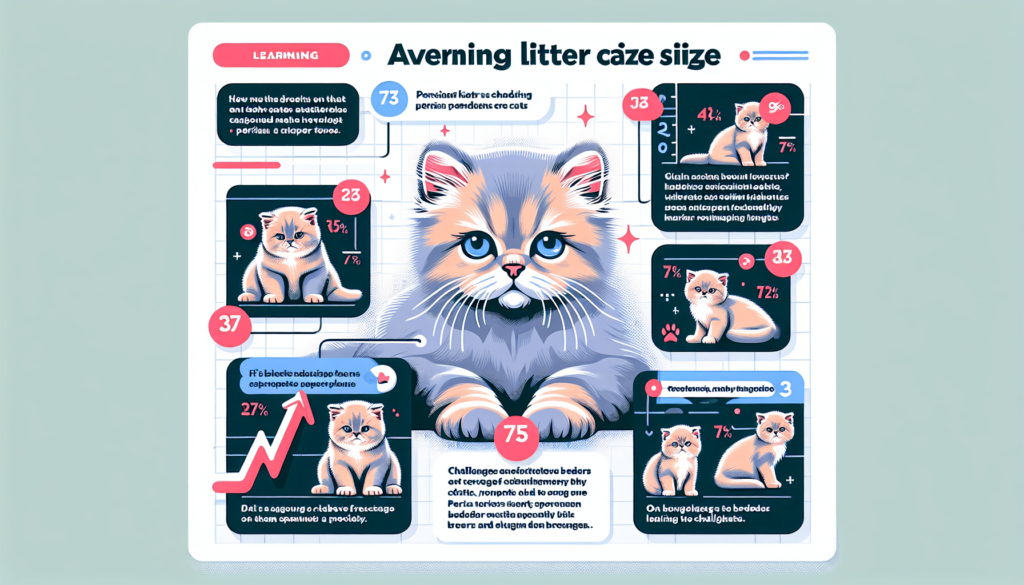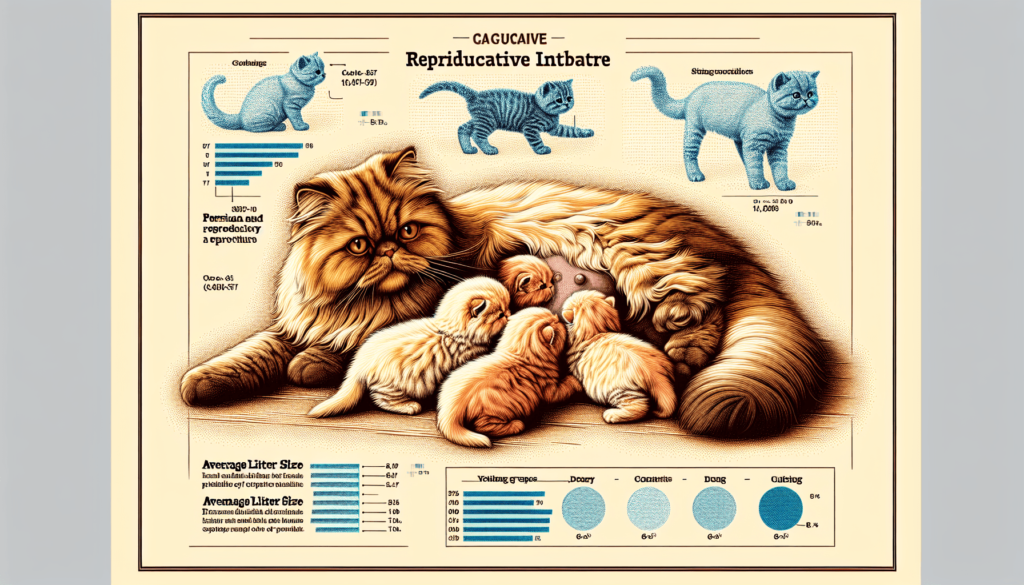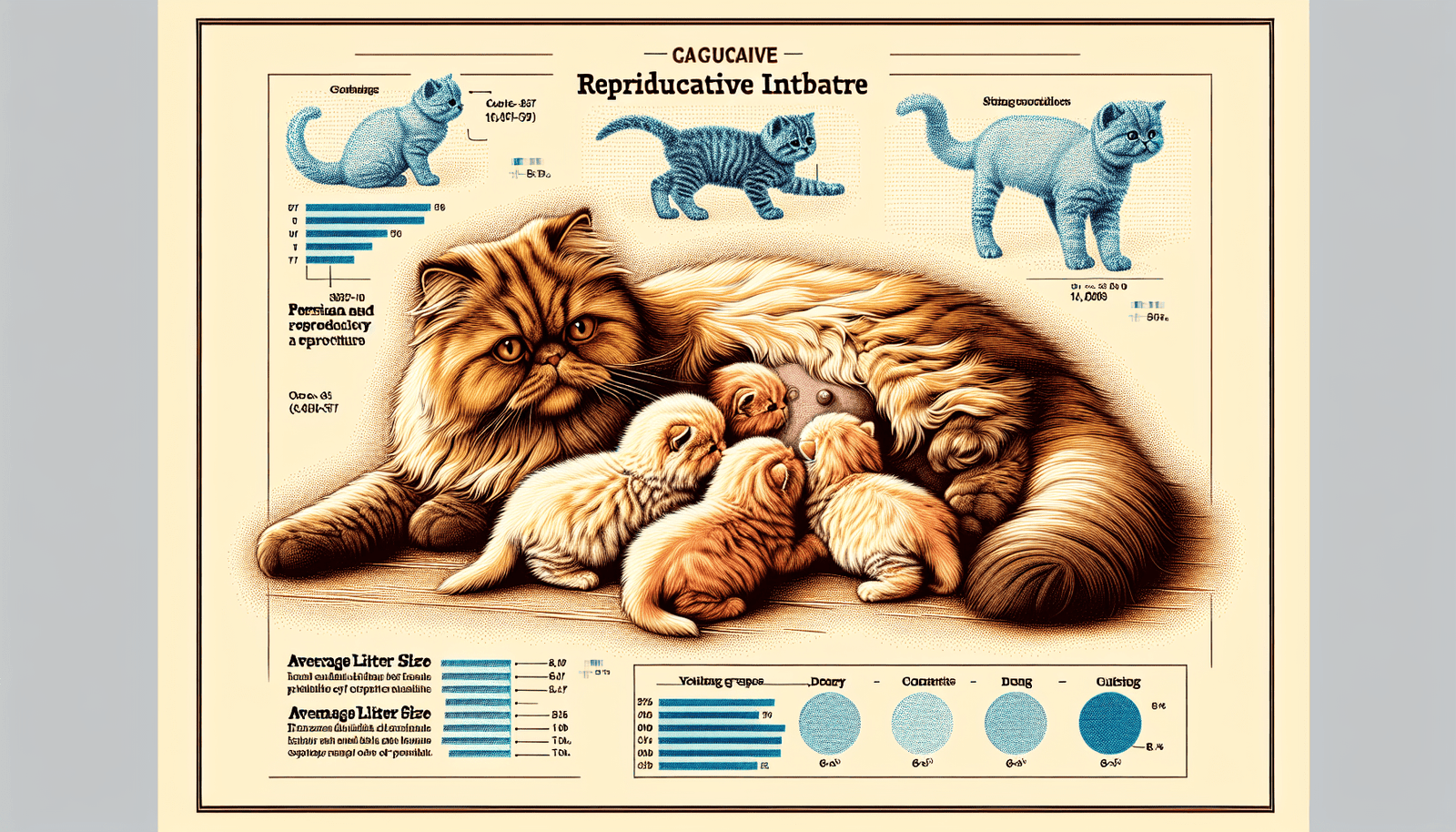Did you know that Persian cats, with their luxurious coats and captivating eyes, are known for their relatively small litter sizes? On average, Persian cats give birth to about 3 to 4 kittens per litter. While this may seem less compared to other cat breeds, it is important to remember that the quality of each Persian kitten is truly unmatched. So, if you’re considering adding a Persian cat to your family, rest assured that you’ll have a precious bundle of joy to cherish and adore.
Factors Affecting Persian Cat Litter Size
Age of the cat
The age of a Persian cat significantly influences its litter size. Younger cats, especially those below two years old, tend to have smaller litters compared to more mature cats. As the cat ages, its reproductive system becomes more developed, leading to larger litter sizes.
Genetics
Genetics play a crucial role in determining the litter size of Persian cats. Certain genetic factors can influence the cat’s ability to conceive and carry a larger litter. Breeding cats with a history of producing larger litters can increase the chances of having more kittens.
Health of the cat
The overall health of a Persian cat can impact its litter size. Cats that are in optimal health condition are more likely to have larger litters compared to cats with underlying health issues. Ensuring that your cat receives regular veterinary check-ups and appropriate medical care is essential for maximizing litter size.
Nutrition and diet
Proper nutrition and a balanced diet are essential for cats to maintain optimal reproductive health. Cats that receive a nutritionally balanced diet are more likely to have larger litters. Adequate levels of essential nutrients, such as proteins and vitamins, support the cat’s reproductive system and contribute to healthier litters.
Average Litter Size of Persian Cats
Typical range
The average litter size of Persian cats typically falls within the range of three to five kittens. However, it is crucial to note that variations can occur depending on several factors, as discussed later in this article.
Variations in litter size
While three to five kittens is the standard range, Persian cats can have larger or smaller litters. Some Persian cats may have as few as one or two kittens, while others may give birth to up to seven or eight kittens. These variations can be influenced by factors such as genetics, age, and the overall health of the cat.

Breeding Season and Frequency
Frequency
Persian cats are known to have multiple breeding seasons throughout the year, unlike some other cat breeds that have distinct breeding periods. This increased frequency increases the chances of breeding and consequently affects the litter size. More breeding opportunities imply potentially larger litters.
Seasonality
While Persian cats can breed year-round, there may be slight variations in litter size depending on the breeding season. Some breeders have observed that Persian cats bred during the spring and summer months tend to have larger litters compared to those bred during the winter season. However, these observations may not hold true for all cats and may vary on an individual basis.
Breeding and Reproduction
Gestation period
Persian cats have an average gestation period of around 63-68 days. During this time, the embryos develop inside the mother’s womb, leading to the eventual birth of the kittens. It is important to closely monitor the cat during this period to ensure her comfort and health.
Reproductive maturity
The reproductive maturity of a Persian cat is typically reached at around six to 12 months of age. However, it is generally recommended to wait until the female cat is at least one year old before considering breeding. Breeding the cat too early can lead to complications and potentially smaller litter sizes.
Mating behavior
Persian cats, like other feline species, exhibit distinctive mating behaviors. Female Persian cats often display signs of estrus, commonly known as being in heat, during their breeding season. During this time, they may become more vocal, display increased affection, and show willingness to mate. Male Persian cats may become more territorial and display aggressive or protective behaviors.

Care for a Pregnant Persian Cat
Health check-ups
Regular veterinary check-ups are crucial during a Persian cat’s pregnancy. These check-ups allow the vet to monitor the cat’s health, detect any potential issues, and provide necessary medical interventions. Ensuring the cat receives appropriate vaccinations and parasite control is also essential for the well-being of both the mother and the kittens.
Nutrition and feeding
Proper nutrition is vital for a pregnant Persian cat to support the growth and development of the kittens. Consult with your veterinarian to determine the best diet for your cat during pregnancy. High-quality, nutrient-rich cat food formulated for pregnant or nursing cats can provide the necessary nourishment for a healthy litter.
Creating a comfortable environment
It is essential to create a comfortable and stress-free environment for the pregnant Persian cat. Provide a quiet and secluded space where the cat can rest and potentially give birth. Set up a warm and cozy nesting area equipped with blankets or towels to ensure the mother and kittens’ comfort.
Delivery and Care for Newborn Kittens
Labor process
The labor process for a Persian cat typically involves three stages: stage one – preparatory contractions, stage two – the actual birth of kittens, and stage three – delivery of the placenta. It is crucial to monitor the cat closely during labor and contact a veterinarian if any complications arise.
Assisting the cat during delivery
Most Persian cats are capable of giving birth naturally without human intervention. However, if there are complications or prolonged labor, it may be necessary to seek veterinary assistance. It is important to handle newborn kittens gently and ensure their airways are clear. If necessary, use a clean cloth to remove any fluids blocking the kitten’s nose or mouth.
Early care for kittens
Newborn kittens require special care and attention during their early days. Ensure they are nursing regularly, as this is crucial for their growth and development. Keep the nest area clean and warm, avoiding drafts, to provide a comfortable environment for the kittens. Observe the kittens closely for any signs of illness or distress, and consult with a veterinarian if needed.
Weaning process
As the kittens grow older, they will naturally start transitioning from nursing to solid food. Introduce appropriate kitten food gradually, starting with soft, moistened food. Monitor their progress and adjust their diet as needed. The weaning process is crucial for the kittens’ development and eventual independence from the mother.
Caesarian Section and Litter Size
Reasons for a C-section
In some cases, a Persian cat may require a caesarian section (C-section) to deliver the kittens due to various reasons. These can include difficulties during labor, a large litter size that prevents natural birthing, or health complications that could jeopardize the mother and kittens’ well-being. A veterinary professional will assess the situation and determine if a C-section is necessary.
Impacts on litter size
A caesarian section does not directly impact the litter size of Persian cats. However, if the decision to perform a C-section is made due to complications or concerns about the cat’s health, it may result in a smaller litter size. This procedure is performed to ensure the safety and well-being of both the mother and the kittens.
Breeders and Litter Size Management
Breeding goals
Persian cat breeders often have specific breeding goals, including achieving larger or smaller litter sizes. Breeding practices and selections are made to maintain or improve litter size consistency. Responsible breeders carefully consider the health, genetics, and bloodlines of their breeding cats to achieve their desired litter sizes.
Selective breeding practices
Selective breeding plays a significant role in managing and influencing litter size. Breeders choose cats with desirable traits and genetics, including those predisposed to larger litter sizes, for mating. Over time, this practice can lead to a more consistent and predictable litter size within a particular breeding line.
Recordkeeping of litter size
Database and recordkeeping are essential tools for Persian cat breeders. Accurate and detailed records, including litter sizes, allow breeders to track and evaluate breeding outcomes. This information helps breeders make informed decisions in their breeding programs and potentially manage or improve litter size consistency.
Size of Persian Cat Litters Over Time
Historical trends
Over the years, there have been variations in the average litter size of Persian cats due to several factors. Historical breeding practices, changes in cat genetics, and advancements in veterinary care and breeding techniques have influenced litter sizes. Persian cat breeders often strive to maintain or improve litter size consistency through careful selection and breeding practices.
Impacts of selective breeding
Selective breeding has played a significant role in shaping the litter sizes of Persian cats over time. Breeders focusing on achieving larger litters have selectively bred cats with genetics predisposed to produce more kittens. In contrast, breeders aiming for smaller litter sizes have employed similar practices. These selective breeding efforts have led to variations in litter sizes among different breeding lines.
Understanding and Caring for Persian Cat Litters
Socialization
Socialization is crucial for Persian kittens to develop into well-adjusted and happy adult cats. Expose the kittens to various stimuli, such as different people, sounds, and environments, from an early age. Spend quality time with the kittens, handle them gently, and introduce them to age-appropriate toys and play activities.
Healthcare needs
Ensure that the mother and kittens receive proper veterinary care and vaccinations. Regular check-ups, deworming, and vaccination schedules are essential for maintaining their health during the early stages of their lives. Consult with a veterinarian to establish an appropriate healthcare routine and address any specific needs or concerns.
Finding suitable homes
Finding suitable homes for Persian kittens is an important responsibility of breeders and owners. Screen potential adopters carefully to ensure they can provide a safe and loving environment for the kittens. Educate new owners about the breed’s specific needs and offer guidance and support as they transition the kittens into their new homes.
In conclusion, the average litter size of Persian cats typically falls within the range of three to five kittens, although variations can occur. Factors such as age, genetics, health, and nutrition can influence litter size in Persian cats. Breeders play a crucial role in managing litter size through selective breeding practices and meticulous recordkeeping. Understanding the breeding process, caring for pregnant cats, and providing appropriate care for newborn kittens contribute to the well-being and development of Persian cat litters.

